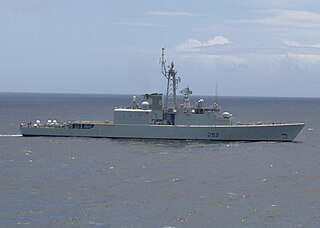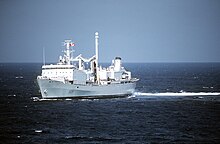
The Gulf War was an armed conflict between Iraq and a 42-country coalition led by the United States. The coalition's efforts against Iraq were carried out in two key phases: Operation Desert Shield, which marked the military buildup from August 1990 to January 1991; and Operation Desert Storm, which began with the aerial bombing campaign against Iraq on 17 January 1991 and came to a close with the American-led liberation of Kuwait on 28 February 1991.

Australia joined a U.S.-led coalition in the Iraq War. Declassified documents reveal that the decision to go to war was taken primarily with a view to enhancing its alliance with the United States.

Operation Granby, commonly abbreviated Op Granby, was the code name given to the British military operations during the 1991 Gulf War. 53,462 members of the British Armed Forces were deployed during the conflict. Forty-seven British personnel were killed during Op Granby and many more were injured during the hostilities there. The total cost of operations was £2.434 billion (1992), of which at least £2.049 billion was paid for by other nations such as Kuwait and Saudi Arabia. £200 million of equipment was lost or written off.

The Royal Canadian Navy is the naval force of Canada. The navy is one of three environmental commands within the Canadian Armed Forces. As of February 2024, the RCN operates 12 Halifax-class frigates, 12 Kingston-class coastal defence vessels, 4 Victoria-class submarines, 4 Harry DeWolf-class offshore patrol vessels, 8 Orca-class patrol vessels, and several auxiliary vessels. The RCN consists of 8,400 Regular Force and 4,100 Primary Reserve sailors, supported by 3,800 civilians. Vice-Admiral Angus Topshee is the commander of the Royal Canadian Navy and chief of the Naval Staff.

The Fifth Fleet is a numbered fleet of the United States Navy. Its area of responsibility encompasses approximately 2.5 million square miles, and includes the Persian Gulf, Red Sea, Arabian Sea, and parts of the Indian Ocean. It shares a commander and headquarters with U.S. Naval Forces Central Command (NAVCENT) in Bahrain. Fifth Fleet/NAVCENT is a component command of, and reports to, U.S. Central Command (CENTCOM).

Iroquois-class destroyers, also known as Tribal class or DDG 280 class, were a class of four helicopter-carrying, guided missile destroyers of the Royal Canadian Navy. The ships were named to honour the First Nations of Canada.

HMCS Athabaskan was an Iroquois-class destroyer that served in the Royal Canadian Navy from 1972 until 2017. Athabaskan was the third ship of her class which is sometimes referred to as the Tribal class or simply as the 280 class. She is the third vessel to use the designation HMCS Athabaskan.

HMCS Calgary is a Halifax-class frigate that has served in the Canadian Forces and Royal Canadian Navy since 1995. Calgary is the sixth vessel in her class and the second vessel to carry the name Calgary. She was built as part of the Canadian Patrol Frigate Project. Calgary began the FELEX refit in June 2012. She is assigned to Maritime Forces Pacific (MARPAC) and is homeported at CFB Esquimalt. Calgary serves on MARPAC missions protecting Canada's sovereignty in the Pacific Ocean and enforcing Canadian laws in its territorial sea and exclusive economic zone.

HMCS Ottawa is a Royal Canadian Navy Halifax-class frigate. Ottawa is the twelfth and final ship of the Halifax class that were built as part of the Canadian Patrol Frigate Project. She is the fourth vessel to carry the name HMCS Ottawa. The first three were named for the Ottawa River. This ship is the first named for Canada's national capital, the City of Ottawa. She is assigned to Maritime Forces Pacific (MARPAC) and is homeported at HMC Dockyard, CFB Esquimalt. Ottawa serves on MARPAC missions protecting Canada's sovereignty in the Pacific Ocean and enforcing Canadian laws in its territorial sea and Exclusive Economic Zone. Ottawa has also been deployed on missions throughout the Pacific and to the Indian Ocean; specifically the Persian Gulf and Arabian Sea on anti-terrorism operations.

HMCS Regina is a Halifax-class frigate that has served in the Canadian Forces and Royal Canadian Navy since 1993. Regina is the fifth vessel in her class which is the name for the Canadian Patrol Frigate Project. She is the second vessel to carry the designation HMCS Regina. She is assigned to Maritime Forces Pacific (MARPAC) and is homeported at CFB Esquimalt.

HMCS Winnipeg is a Halifax-class frigate that has served in the Royal Canadian Navy since 1996. Winnipeg is the ninth ship in her class, whose design emerged from the Canadian Patrol Frigate Project. She is the second Canadian warship to carry the name HMCS Winnipeg. Winnipeg serves on Canadian Forces MARPAC missions protecting Canada's sovereignty in the Pacific Ocean and the Arctic Ocean and in enforcing Canadian laws on its territorial oceans and Exclusive Economic Zone. The vessel has been deployed on missions throughout the Pacific, and also to the Indian Ocean; specifically on anti-terrorism operations in the Persian Gulf and the Arabian Sea, and counter-piracy operations off the coast of Somalia. The ship is assigned to the Maritime Forces Pacific (MARPAC), and she has her home port at the Canadian Forces Maritime Base at Esquimalt.

HMCS Algonquin was an Iroquois-class destroyer that served in the Royal Canadian Navy (RCN) from 1973 to 2015.

HMCS Huron was an Iroquois-class destroyer that served with the Canadian Forces from 16 December 1972 to 23 October 2000. She served mainly on the western coast of Canada. After decommissioning, her hull was stripped to be used in a live-fire exercise. The ship's hulk was eventually sunk by gunfire from her sister ship, HMCS Algonquin. Huron was the second ship of her class and the second vessel to use the designation HMCS Huron.

HMCS Iroquois was the lead ship of the Iroquois-class destroyers of the Royal Canadian Navy, also known as the Tribal class or the 280 class. The second vessel to carry the name, she carried the hull number DDG 280. Entering service in 1972 she was assigned to Maritime Forces Atlantic (MARLANT) and was homeported at CFB Halifax. Iroquois was deployed overseas for blockade and anti-terrorism duties, including participating in Operation Apollo in 2002–03. Taken out of service in 2014 and paid off in 2015.

Her Majesty's Canadian Ship (HMCS) Protecteur was the lead ship of the Protecteur-class replenishment oilers in service with the Royal Canadian Navy. She was part of Maritime Forces Pacific (MARPAC), homeported at CFB Esquimalt, British Columbia. Built by Saint John Shipbuilding and Dry Docks in Saint John, New Brunswick, she was commissioned on 30 August 1969. She was the first Canadian naval unit to carry the name Protecteur; however, there have been several units, including a base, named HMCS Protector.
Operation Altair was the Canadian Forces maritime contribution to the U.S.-led coalition anti-terrorist campaign known as Operation Enduring Freedom (OEF). Operation Altair mainly consisted of single ship deployments. HMCS Toronto, a Halifax-class patrol frigate with an embarked helicopter detachment, was the first ship to sail under Operation Altair. She deployed from January to July 2004, sailing with the USS George Washington Carrier Strike Group. However, due to operational requirements elsewhere around the world, there were periods when there was no Canadian maritime contribution to OEF.

On 29 November 1990, the adoption of United Nations Security Council Resolution 678 authorized the assembly of a multinational military coalition to liberate Iraqi-occupied Kuwait by "all necessary means" if Iraq did not withdraw its forces by 15 January 1991. Iraq failed to do so, and the coalition began an aerial bombardment against targets in Iraq and Kuwait on 17 January 1991. At this time, the coalition consisted of 42 countries and was spearheaded by the United States. The central command was led by the United States, Saudi Arabia, and the United Kingdom; the marine command was led by the United States; the Joint Forces East Command was led by Egypt, Saudi Arabia, Syria, Morocco, Kuwait, Oman, the United Arab Emirates, Qatar, Bahrain, Poland, and Czechoslovakia; and the Joint Forces North Command was led by the United States, the United Kingdom, France, Canada, Italy, Australia, and Turkey.

Operation Mobile was the name given to Canadian Forces activities in the 2011 military intervention in Libya. The United States' counterpart to this was Operation Odyssey Dawn, the French counterpart was Opération Harmattan and the British counterpart was Operation Ellamy. The no-fly zone was proposed during the Libyan Civil War to prevent government forces loyal to Muammar Gaddafi from carrying out air attacks on anti-Gaddafi forces and civilians. The demonstrations in Libya were part of the larger Arab Spring movement that began in the country of Tunisia on 18 December 2010. When demonstrations began in Libya, the government of Muammar Gaddafi responded with systematic attacks by air and ground forces, and repression of the protesters. In a speech, Gaddafi promised to chase down the protesters and cleanse the country "house by house". Several countries prepared to take immediate military action at a conference in Paris on 19 March.
Vice-Admiral Robert Earl Douglas George CMM, CD is a retired officer of the Canadian Forces. He was the 22nd Commander Maritime Command from 1 August 1989 to 12 July 1991.
The following is a hierarchical outline for the Canadian Armed Forces at the end of the Cold War. It is intended to convey the connections and relationships between units and formations.


















